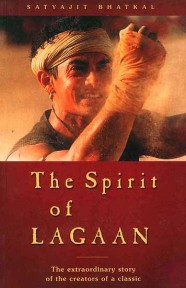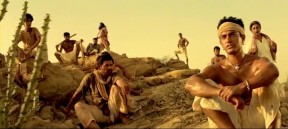Almost 10 years ago, when I used to stretch my meagre salary to watch two, sometimes three films a week in single screen halls and review them for The New Indian Express in Bangalore, a certain day remains easier to recall than all the others. It was the day I watched Anil Sharma’s Gadar-Ek Prem Katha and Ashutosh Gowariker’s Lagaan, back to back.
It was raining when I stepped out after watching Gadar and wondered if I would have the energy to watch Lagaan after this long, emotionally exhausting but undeniably entertaining film with its moving Partition scenes and the unbelievable comic book climax. And the hand pump plucking patriotism that seemed to have gone down well with the audience. But I did go to watch Lagaan. It languidly worked its way to the climax when suddenly the theatre began to sound like an uproarious cricket stadium during a World-Cup final. I still remember the headline that went with the review the next day,”Near Perfect.”
 A few months later Satyajit Bhatkal, Aamir Khan’s close friend released the book The Spirit Of Lagaan and came to Bangalore with Khan (more about that meeting here http://unboxedwriters.com/2011/03/decoding-aamir-khan/) to promote it.
A few months later Satyajit Bhatkal, Aamir Khan’s close friend released the book The Spirit Of Lagaan and came to Bangalore with Khan (more about that meeting here http://unboxedwriters.com/2011/03/decoding-aamir-khan/) to promote it.
By that time, the film had already been acknowledged as a modern classic and had been to the Oscars. 10 years later when a decade of Lagaan is being celebrated, am going through the book again and wondering if the writer knew during the film’s arduous journey from dream to fulfilment that he was not just watching a career defining moment in the lives of Gowariker and Khan but also the making of cinematic history. He does say somewhere near the end, “We had come to make a film, yet the film had in many ways made us.”
What was it about Lagaan that has refused to fade away from memory? I can only think of one word. Purity. It was an incredibly pure film. Its intention to tell an uncompromised story with passion, with integrity and without emotional manipulation.
Lagaan had the innocence of Naya Daur, the fragrance of rusticity and rural India that has vanished from our multiplex driven cinema, a narrative moulded in the manner of Mehboob Khan’s Mother India, Bimal Roy’s Do Beegha Zameen. And glorious music picturised the way its should be. Every note, every lyric caressed by the camera. Lagaan was like a love letter written to the masters. To men who made films like they had all the time in the world. To stories that did not titillate your senses but moved and stirred your soul. It was a tribute to the best films ever made in the history of Hindi cinema.
Lagaan was not a film made in a hurry. It was not made to please the distributors, the critics. It was its own purpose and Gowariker who no longer wanted to be a deal maker but a path breaker, went out on a limb with a script no producer was willing to touch. Bhatkal’s book recalls the evening Gowariker came to Aamir Khan’s house to narrate the story. In a room filled with prospective members of the cast that would one day animate Lagaan, the narration began and at the end Bhatkal recalls, “I was emotionally overwhelmed. I felt as if I had been privileged to preview an emotionally ambitious artistic creation. The innocence and naivety of the story and characters -qualities long missing in modern cinema and modern life-captivated me.”
The book traces the search for the location of Champaner (the village where the story unfolds), the struggle to find the British cast and the perfect Gauri for Aamir Khan’s Bhuvan. It details the demanding process of building a 19th century cricket pavillion in the middle of the Kutch desert as earthmovers first uprooted the babool weed and then 200 trucks brought the soil needed to level the ground. It took almost 1000 tonnes of fresh gobar to plaster the Champaner of Gowariker’s dreams and the crew then hunted for 100 year old props like pots, cots, window handles, cradles and a 19th century potter’s wheel.
And ofcourse the music and the man who created it. Recalls Bhatkal, “Rahman composes in his ground floor studio lit by the candles from a famous dargah. Incense permeates the atmosphere. Working in a state-of-the-art studio, Rahman appears to be a mystic in a cave. From Chennai, Ashutosh played the selected tunes for Aamir who is in Mumbai, via a Walkman held to the mouthpiece of a telephone. The technology is rather old fashioned but so are the songs.”
More trivia lights up the book.
A 60 room, fully air-conditioned facility was set up to accommodate the cast in Bhuj.
Cinematographer Anil Mehta was alarmed by the extent to which the sandy soil in the ‘village’ reflected light so the entire village was caked with a mixture of cow dung and a special soil.
A 10,000 square feet structure was built on location to feed, dress, and rest the huge cast. Another township was created for the animals used in the shoot. Several lakhs were spent just to feed them.
Nearly 10000 people were required to shoot the cricket scenes and 95 trucks and 40 trailor tractors were used to carry them to the location.
Half-way through the shoot, the director suffered a slipped disk and directed the rest of the film from a portable, wooden bed.
Aamir and his first wife Reena, performed Kanyadan at the wedding of two British actors, in the temple on location.
Gowariker and Javed Akhtar sang the bhajan, “O Palan Haare” before the unit one evening, moving everyone to tears.
Lagaan was the longest, single schedule film, shot over a span of six months.
Gracy Singh danced through the Radha Kaise Na Jale sequence with an infected wound in one of her earlobes, caused by her heavy silver earrings.
The famous Jonty Rhodes catch taken in the climax by Lakha (Yashpal Sharma) was okayed in the 28th take with the help of a trampoline and a matteress.
At the end of the shoot, the land taken from the villagers had to be given back and so the Champaner set which had taken such passion to build was sprayed with kerosene and burnt down, leaving the crew in tears.
 The rest is ofcourse history that we are still recounting 10 years later.
The rest is ofcourse history that we are still recounting 10 years later.
Lagaan was simply a great story told simply. It was not the flavour of the season but part of the heritage we dismissively refer to as Bollywood. Lagaan is also one of the reasons why I chose to revisit Champaner this week instead of sitting through Bheja Fry-2 and Always Kabhi Kabhi.
Because some films remind you everytime you watch them that going to the movies can be an uplifting, life-affirming experience. And as Bhatkal says, that is possible only when, “what happens behind the scenes is much larger than what happens on screen.”
Reema Moudgil is the author of Perfect Eight (http://www.flipkart.com/b/books/perfect-eight-reema-moudgil-book-9380032870?affid=unboxedwri )








Beautiful Piece!